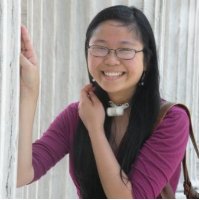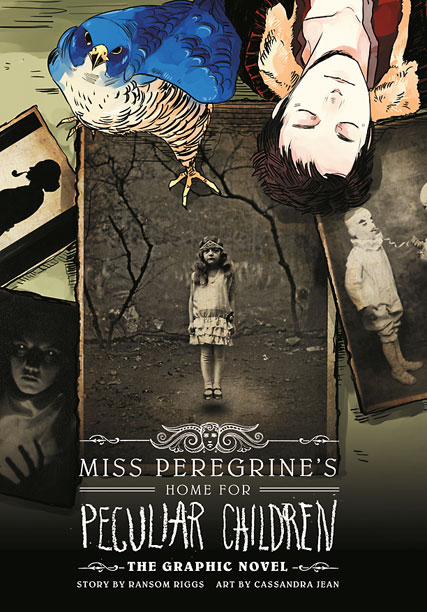Every month or two, DIY MFA’s Wendy Lu will be hosting “New Spin,” a column that covers everything that falls within alternative storytelling: literary mash-ups, books that put a new spin on classic stories, and “meta-books” that use new media, graphic illustrations, and interaction between words/design for an enhanced reader experience.
Supernatural, eerie, weird. These are some of the words readers have used to describe Miss Peregrine’s Home for Peculiar Children (Quirk Books), a fiction novel based on antique photographs of children that author Ransom Riggs had collected. Now a New York Times bestseller, the book follows a 16-year-old boy named Jacob, who experiences a terrible family tragedy and then finds himself traveling to an island in Wales, where he discovers an abandoned orphanage that holds secrets about his grandfather’s past.
The story is told partly through fantasy storytelling and partly through vintage photography, making for an enhanced reader experience. But what started out as an unconventionally written story back in June 2011 has now been transformed into its own graphic novel.
__
Visual Storytelling
Miss Peregrine’s Home for Peculiar Children: The Graphic Novel (Yen Press) was released on Oct. 29, more than two years after the original book came out.
Crafting a graphic novel based on a pre-existing book that already possesses visual elements might seem simple, but it takes a lot more than just cutting and pasting text and then adding a few drawings.
For Cassandra Jean, the graphic novelist for Miss Peregrine, it’s about pacing and story flow. It’s about figuring out what scenes in the book are most important, counting the number of comic pages each scene will take up, and shortening scenes as necessary.
“Since I can’t make the graphic novel a thousand pages, sometimes I have to edit scenes so that they will make sense in the more condensed version that I am producing,” says Jean, who read the book twice after her publisher handed it over.
As part of the planning process, Jean first marked the pages that included particular scenes, locations and character descriptions that would make up the bulk of the graphic novel. Those textual descriptions turned into Jean’s initial character designs, which Riggs had to approve of before signing Jean on as the official artist for the project.
Every detail about a character’s personality contributed to the visual depiction of that character – or, in Jean’s words, “you don’t just read about Jacob reacting to the Peculiars, but actually see him reacting.”
The Graphic Novel versus The Book
Jean, who usually draws in black and white, says she had to draw Miss Peregrine’s Home for Peculiar Children entirely in color and work with Riggs’ photographs – neither of which she’d ever done before.
“Both incorporating the pictures into the comic as well as designing characters based on these very old, very strange photos, was a new experience,” Jean says. “The novel itself was already pretty visual, so there was some pressure to make sure that the graphic novel was worth it, that it could really contribute something to the Miss Peregrine universe that the novel itself wasn’t already doing.”
Inevitably, some story content had to be removed so that the graphic novel read smoothly throughout.
“[That’s] always tough because you want to keep true to the book, but you have to keep in mind that it is a different medium and sometimes changes need to be made,” Jean says.
One of the greatest drawing challenges for Jean was the mysterious house that the orphans live in, a significant part of the novel’s setting. After making changes to several pages that included designs of the house, she says the final version of the house matched up with what Riggs had envisioned.
Jean says novels inspire readers to use their imagination and visualize the scenes in their minds, and Miss Peregrine’s Home for Peculiar Children is no exception.
“Hopefully, the graphic novel adds a new layer to the experience by bringing the words to life in a visual way,” she says.
The Beauty of Graphic Novels
Miss Peregrine’s Home for Peculiar Children is one out of many books that have been adapted into graphic novels – others include Twilight by Stephenie Meyer, A Game of Thrones by George R. R. Martin, The Lightning Thief by Rick Riordan, and soon, Speak by Laurie Halse Anderson.
Jean says the attraction behind graphic novels lies in the artwork, which makes the entire reading experience much more visual than if there are only words to unfold the scene for you.
“When I’m reading a novel, I usually speed through it, eager to find out what happens, to get to the ending. But when I read a graphic novel, I linger over each page more. Not because I don’t want to find out what happens, but because there is just so much to see,” Jean says. “I like to pause and admire the artwork, to look at the characters, the style, the backgrounds. To look at the subtle expressions that you can see on the character’s faces.”
Her next project will be The Secret Treasons, a graphic novel that will be part of fantasy author Cassandra Clare’s The Shadowhunter Chronicles. While Jean says she “adores drawing illustrations based on novels,” working on The Secret Treasons will be exciting because it is a new work to be published rather than an adaptation of one.
For aspiring graphic novelists and writers, Jean says it’s imperative to keep working and staying dedicated to the craft.
“It’s a hard business to break into, whether it’s the writing or the drawing side of things,” Jean says. “Creative jobs are hard to get into, because it takes a lot of dedication and passion (be it writing, drawing, acting, music, etc.). But it’s not impossible, especially if you are willing to put in the time and energy needed to always be improving and finding new projects to work on.”
 Cassandra Jean is a freelance illustrator and comic artist who spends her days toiling with a pen in her hand and her faithful dog sleeping at her feet. The radio is always on, and Gatorade is a constant source of power! Email her at casspiedra@gmail.com, tweet her @CassandraJP, or follow her on https://cassandrajeanart.blogspot.com. Check out her art at https://cassandrajp.tumblr.com.
Cassandra Jean is a freelance illustrator and comic artist who spends her days toiling with a pen in her hand and her faithful dog sleeping at her feet. The radio is always on, and Gatorade is a constant source of power! Email her at casspiedra@gmail.com, tweet her @CassandraJP, or follow her on https://cassandrajeanart.blogspot.com. Check out her art at https://cassandrajp.tumblr.com.
……………………………………………………………………………………………………………………………………………………………………………………………………..
 Wendy Lu is co-editor of The Durham VOICE and the entertainment editor at Blue & White magazine. She is also a former book publishing intern and a NaNoWriMo 2008 winner. Her work has appeared in The Daily Tar Heel, Raleigh Public Record and Chapel Hill Magazine’s The WEEKLY. She blogs about creativity and happiness at https://wendyluwrites.blogspot.com.
Wendy Lu is co-editor of The Durham VOICE and the entertainment editor at Blue & White magazine. She is also a former book publishing intern and a NaNoWriMo 2008 winner. Her work has appeared in The Daily Tar Heel, Raleigh Public Record and Chapel Hill Magazine’s The WEEKLY. She blogs about creativity and happiness at https://wendyluwrites.blogspot.com.







